

Field Trips Announced for 45th Annual Spring Mt. Rogers Naturalist Rally
If you were to glance at a biodiversity hotspot map of the United States, you would see a striking pop of color stretching across the heart of the Blue Ridge Mountains, with the highest level of diversity right here in our backyard among the three highest peaks of Virginia: Mount Rogers, Whitetop Mountain, and Pine Mountain. Is it any coincidence, then, that people have been coming to this region for 45 years to take part in the Mount Rogers Naturalist Rally?


Virginia Master Naturalist Course begins this week!
Love Southwest Virginia? Want to learn more about it? The Holston Rivers Chapter Virginia Master Naturalist Basic Training Course begins this Thursday. If you’re ready to connect with the natural history of our region as a Master Naturalist, check out the course details here and register today!

The Blue Ridge: A Geological Autobiography
If the Blue Ridge could write its own long and complex history, surely it would chisel the words in stone. Fortunately, it did just that. And fortunately, we have a translator in our midst. During our January 2019 Geology Expedition, USGS Geologist Arthur Merschat unraveled the story of the geologic events that left Virginia’s oldest basement rocks exposed for us to access and admire.
New River Expedition 2018!
Being in the thick of winter we thought it might be a good time to compile the footage from our New River Expedition last summer, when the days were hot, long, and filled with all sorts of fun!

Experience 2019 with Blue Ridge Discovery Center
In the quiet of the winter woods you may see a blanket of fallen leaves or a dusting of snow and think of the life resting beneath it, awaiting the rains and warmer temperatures of spring before emerging to bloom or forage. But not all life is waiting out the winter.